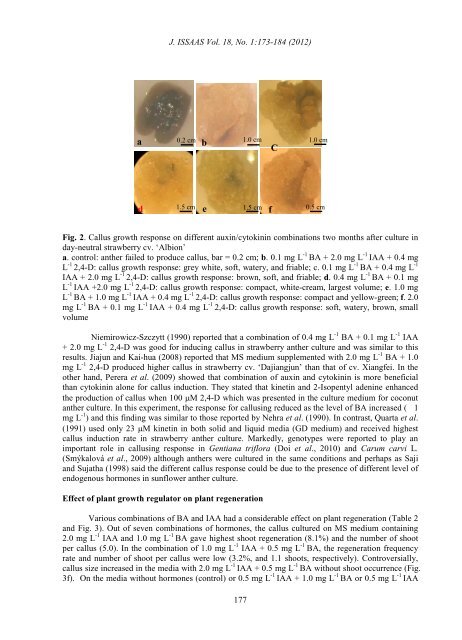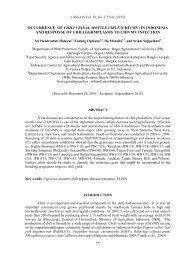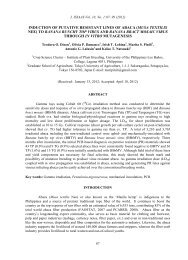Haploid plant production through anther culture in day-neutral
Haploid plant production through anther culture in day-neutral
Haploid plant production through anther culture in day-neutral
Create successful ePaper yourself
Turn your PDF publications into a flip-book with our unique Google optimized e-Paper software.
J. ISSAAS Vol. 18, No. 1:173-184 (2012)a0.2 cmcmb1.0 cmcmC1.0 cmde1.5 cm 1.5 cm 0.5 cmfFig. 2. Callus growth response on different aux<strong>in</strong>/cytok<strong>in</strong><strong>in</strong> comb<strong>in</strong>ations two months after <strong>culture</strong> <strong>in</strong><strong>day</strong>-<strong>neutral</strong> strawberry cv. ‘Albion’a. control: <strong>anther</strong> failed to produce callus, bar = 0.2 cm; b. 0.1 mg L -1 BA + 2.0 mg L -1 IAA + 0.4 mgL -1 2,4-D: callus growth response: grey white, soft, watery, and friable; c. 0.1 mg L -1 BA + 0.4 mg L -1IAA + 2.0 mg L -1 2,4-D: callus growth response: brown, soft, and friable; d. 0.4 mg L -1 BA + 0.1 mgL -1 IAA +2.0 mg L -1 2,4-D: callus growth response: compact, white-cream, largest volume; e. 1.0 mgL -1 BA + 1.0 mg L -1 IAA + 0.4 mg L -1 2,4-D: callus growth response: compact and yellow-green; f. 2.0mg L -1 BA + 0.1 mg L -1 IAA + 0.4 mg L -1 2,4-D: callus growth response: soft, watery, brown, smallvolumeNiemirowicz-Szczytt (1990) reported that a comb<strong>in</strong>ation of 0.4 mg L -1 BA + 0.1 mg L -1 IAA+ 2.0 mg L -1 2,4-D was good for <strong>in</strong>duc<strong>in</strong>g callus <strong>in</strong> strawberry <strong>anther</strong> <strong>culture</strong> and was similar to thisresults. Jiajun and Kai-hua (2008) reported that MS medium supplemented with 2.0 mg L -1 BA + 1.0mg L -1 2,4-D produced higher callus <strong>in</strong> strawberry cv. ‘Dajiangjun’ than that of cv. Xiangfei. In theother hand, Perera et al. (2009) showed that comb<strong>in</strong>ation of aux<strong>in</strong> and cytok<strong>in</strong><strong>in</strong> is more beneficialthan cytok<strong>in</strong><strong>in</strong> alone for callus <strong>in</strong>duction. They stated that k<strong>in</strong>et<strong>in</strong> and 2-Isopentyl aden<strong>in</strong>e enhancedthe <strong>production</strong> of callus when 100 M 2,4-D which was presented <strong>in</strong> the <strong>culture</strong> medium for coconut<strong>anther</strong> <strong>culture</strong>. In this experiment, the response for callus<strong>in</strong>g reduced as the level of BA <strong>in</strong>creased (≥ 1mg L -1 ) and this f<strong>in</strong>d<strong>in</strong>g was similar to those reported by Nehra et al. (1990). In contrast, Quarta et al.(1991) used only 23 M k<strong>in</strong>et<strong>in</strong> <strong>in</strong> both solid and liquid media (GD medium) and received highestcallus <strong>in</strong>duction rate <strong>in</strong> strawberry <strong>anther</strong> <strong>culture</strong>. Markedly, genotypes were reported to play animportant role <strong>in</strong> callus<strong>in</strong>g response <strong>in</strong> Gentiana triflora (Doi et al., 2010) and Carum carvi L.(Smýkalová et al., 2009) although <strong>anther</strong>s were <strong>culture</strong>d <strong>in</strong> the same conditions and perhaps as Sajiand Sujatha (1998) said the different callus response could be due to the presence of different level ofendogenous hormones <strong>in</strong> sunflower <strong>anther</strong> <strong>culture</strong>.Effect of <strong>plant</strong> growth regulator on <strong>plant</strong> regenerationVarious comb<strong>in</strong>ations of BA and IAA had a considerable effect on <strong>plant</strong> regeneration (Table 2and Fig. 3). Out of seven comb<strong>in</strong>ations of hormones, the callus <strong>culture</strong>d on MS medium conta<strong>in</strong><strong>in</strong>g2.0 mg L -1 IAA and 1.0 mg L -1 BA gave highest shoot regeneration (8.1%) and the number of shootper callus (5.0). In the comb<strong>in</strong>ation of 1.0 mg L -1 IAA + 0.5 mg L -1 BA, the regeneration frequencyrate and number of shoot per callus were low (3.2%, and 1.1 shoots, respectively). Controversially,callus size <strong>in</strong>creased <strong>in</strong> the media with 2.0 mg L -1 IAA + 0.5 mg L -1 BA without shoot occurrence (Fig.3f). On the media without hormones (control) or 0.5 mg L -1 IAA + 1.0 mg L -1 BA or 0.5 mg L -1 IAA177





